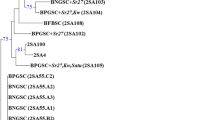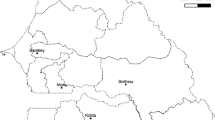Abstract
Two new physiologic races of Erysiphe graminis avenae are described, capable of attacking hitherto resistant hexaploid genotypes of Avena in the seedling stage. Two diploid forms namely A. strigosa var. glabrota and A. strigosa s.sp. hirtula provide the only sources of resistance to the races of mildew isolated in this investigation. In two cultivars, relative degrees of resistance to mildew infection in field trials have been shown to be due to resistance developing in later formed leaves of maturing plants. The importance of developing cultivars with a high degree of “adult plant” resistance to disease attack in the field is discussed.
Similar content being viewed by others
References
Black, W. (1960) Races of Phytophthora infestans and resistance problems in potatoes. Rep. Scott. Pl. Breed. Stn. 1960, 29–38.
Cherewick, W. J. (1944) Studies on the biology of Erysiphe graminis D.C. Can. J. Res. 22, 52–86.
Finkner, R. E., Murphy, H. C. and Atkins, R. E. (1953) Reaction of oat varieties to powdery mildew. Agron. Jour. 45, 92–95.
Grainger, J. (1947) The ecology of Erysiphe graminis D.C.. Trans. Br. mycol. Soc. 31, 54–65.
Griffiths, D. J. (1954) Varietal reaction of oats to crown rust (Puccinia coronata corda) and powdery mildew (Erysiphe graminis D.C.) and a study of the mode of inheritance of resistance to these diseases. Ph. D. thesis, Univ. Wales (Unpublished).
Griffiths, D. J. (1961) Rep. Welsh Pl. Breed. Stn 1960. p. 46.
Hayes, J. D. and Catling, W. S. (1963) Physiological specialization in Erysiphe graminis D.C. in oats. Nature, Lond. 199, 1111–1112.
Jones, E. T. and Griffiths, D. J. (1952) Varietal resistance and susceptibility of oats to powdery mildew (Erysiphe graminis). Trans. Br. mycol. Soc. 35: 71–80.
Large, E. C. and Doling, D. A. (1962) The measurement of cereal mildew and its effect on yield. Pl. Path. 11, 47–57.
Lawes, D. A. and Hayes, J. D. (1965) The effect of mildew (Erysiphe graminis f. sp. avenae) on spring oats. Pl. Path. 14, 125–128.
Macer, R. C. F. (1964) Rep. Pl. Breed. Inst. 1962–63. p. 32.
Samborski, D. J., Forsyth, F. R. and Person, C. (1958) Metabolic changes in detached wheat leaves floated on benzimidazole and the effect of these changes on rust reaction. Can. J. Bot. 36, 591–601.
Wiberg, A. (1962) Further studies on the physiological race specialization of Erysiphe graminis D.C. f. sp. hordei Marchal in Sweden. Phytopath. Z. 44, 324–333.
Williams, W. (1964) Genetical principles and plant breeding. p. 422. Oxford: Blackwell Scientific Publications.
Author information
Authors and Affiliations
Rights and permissions
About this article
Cite this article
Hayes, J.D., Jones, I.T. Variation in the pathogenicity of Erysiphe graminis D.C. F. Sp. Avenae, and its relation to the development of mildew-resistant oat cultivars. Euphytica 15, 80–86 (1966). https://doi.org/10.1007/BF00024081
Received:
Issue Date:
DOI: https://doi.org/10.1007/BF00024081




